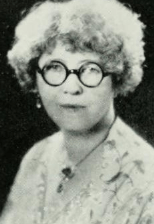Mary Carr Moore facts for kids
Mary Carr Moore (born August 6, 1873 – died January 9, 1957) was an American composer, conductor, singer, and music teacher. She is famous for her work in music on the West Coast during the 1900s.
Contents
Early Life and Musical Start
Mary Louise Carr was born on August 6, 1873, in Memphis, Tennessee. Her parents were Sarah Pratt Carr and Byron Oscar Carr. She spent her early years in Memphis and Louisville, Kentucky. When she was ten, her family moved to the West Coast, where she lived for the rest of her life.
Mary was very talented in music from a young age. She began her studies in San Francisco. There, she learned how to compose music from J. H. Pratt and how to sing from H. B. Pasmore. By 1889, she was already teaching and writing her own music. One of her songs from that year was even published later! In 1894, she starred in her first operetta, The Oracle. An amateur group performed it for the first time in San Francisco. The next year, she stopped singing to focus completely on teaching and composing. She taught in Lemoore, California, starting in 1895, and then moved to Seattle in 1901.
Creating the Opera Narcissa
While living in Seattle, Mary Carr Moore started working on her biggest and most important stage show. This was a four-act grand opera called Narcissa, or The Cost of Empire. The opera told the story of Marcus and Narcissa Whitman. It also covered the attack on their mission in Walla Walla in 1847. Mary's mother, Sarah Carr, wrote the story for the opera.
For the first performance in Seattle in 1912, famous singers came all the way from New York City. There was no conductor available, so Mary Carr Moore herself stepped up to lead the orchestra! Even though it was a big event, the opera did not become a regular show. It soon stopped being performed. However, Mary conducted it again in San Francisco in 1925 and in Los Angeles in 1945.
The Opera David Rizzio
In 1932, Mary Carr Moore was asked to write an opera to be performed in Venice, Italy. She chose a story about Mary, Queen of Scots. This opera, called David Rizzio, was a grand opera with two acts. It was the only work she wrote with an Italian story.
The performance in Venice did not happen. But a group of amateur organizations in Los Angeles worked together to put on the show instead.
Later Career and Teaching
Mary Carr Moore kept writing operas after David Rizzio, but none of them became very famous. She moved to Los Angeles in 1926 and stayed there for the rest of her life. From 1928 to 1947, she taught music theory and composition at Chapman College in Orange, California. She also taught at the Olga Steeb Piano School from 1926 to 1943.
Mary also worked hard to support American music. In 1909, she started an American Music Center in Seattle. From 1936 to 1942, she helped local composers perform their music in Los Angeles. This was part of a government program called the Federal Music Project. In 1930, her opera Narcissa won a special award called the Bispham Memorial Medal Award. In 1936, Chapman College gave her an honorary doctorate degree in music.
Mary Carr Moore passed away on January 9, 1957, in Inglewood, California. She is buried at Inglewood Park Cemetery.
Personal Life
Mary Carr Moore got married in her early twenties, but the marriage lasted just over ten years. She had a daughter named Marian Hall Moore, and two sons, Byron Carr Moore and John Wesley Moore. Later, she remarried, but that relationship also ended. Her son, Dr. John Wesley Moore, died in an airplane crash in 1944 while serving as a military doctor in the US Air Force. Mary stayed close with her family. In her later years, she helped support her divorced daughter, her mother, and two grandsons.
Musical Style
Mary Carr Moore was a traditional composer. Her music often sounded like the Romantic style of the late 1800s. Some of her songs had qualities similar to impressionistic music, which might remind you of Claude Debussy. In her later works, like David Rizzio, she used the whole tone scale more often. However, her music always kept its basic tonal sound. She really disliked modern, experimental music. It is said she once left a performance of a new, unusual piece because it made her feel sick!
Mary Carr Moore was sometimes considered part of the First Los Angeles School of composers.
Legacy and Impact
Mary Carr Moore is remembered today mostly for her efforts to help music grow on the West Coast. She was one of the first composers to promote opera in Seattle. She often helped promote the work of other composers alongside her own. As a teacher, she also supported her students' music. She even started a club for them to regularly perform their own compositions. One of her students was the composer Addie Anderson Wilson.
Recordings
A few of Mary Carr Moore's songs were recorded by Evelyn de la Rosa and David Rudat for Cambria Records in 1984.
Operas
- The Oracle, (1894)
- Narcissa, or The Cost of Empire, (1911)
- The Leper, (written 1912)
- Memories (1914)
- Harmony, (1917)
- The Flaming Arrow, or, The Shaft of Ku' Pish-ta-ya, (1922)
- David Rizzio, (1928)
- Los Rubios, (1931)
- Flutes of Jade Happiness, (1933)
- Légende Provençale, unperformed, orchestral score lost


